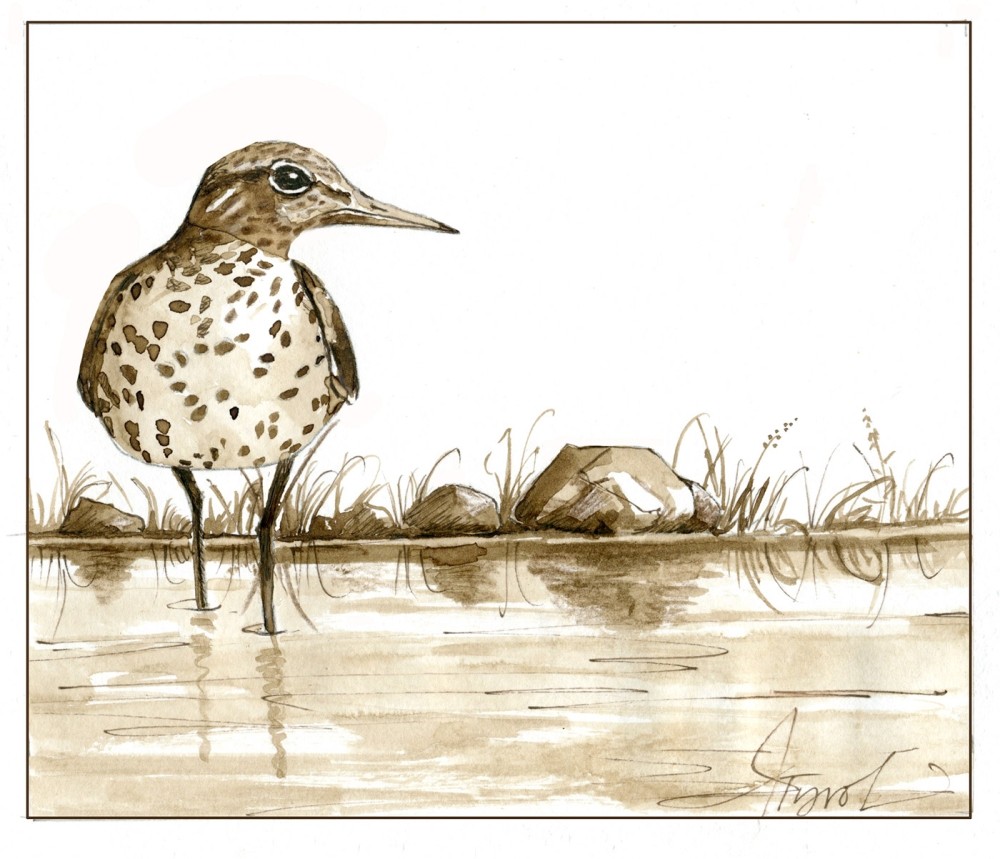
If there’s one place you’d expect to see a sandpiper, it’s on the sand. However, there is one member of this family of shorebirds that prefers streamside to surfside. Almost any time you go for a paddle, you are likely to see small brown birds skimming low across the water with stiff, rapid wingbeats. As they walk along a branch or log, or a muddy stretch of shore, they have a characteristic rear-end bob that never quits. In flight, their calls are an ascending ‘weet-weet-weet.”
These little birds are spotted sandpipers, or, as their friends and admirers call them, “spotties.” They are fascinating birds for several reasons, among them a reversal of sex roles that is very rare in the bird world.
The spotted sandpiper is the most widely distributed sandpiper in North America. While most sandpiper species breed at higher latitudes in Canada, this is one of the few to breed in New England. As sandpipers go, they are medium-sized — 6-7 inches, about the same size as the Eastern phoebe (another noted bobber). The constant up-and-down rocking of its lower body helps distinguish the spotted sandpiper from the common sandpiper, which only bobs a bit. Spotties bob while standing still and while walking. Babies bob within minutes of hatching. Not surprisingly, its nicknames include “teeter-up,” teeter-peep,” “teeter-tail,” “tip-tail,” teeter-snipe,” and “teeter-bob.”
When I spoke with spotted sandpiper expert Dr. Lewis W. Oring, he assumed I was going to ask him why all the bobbing. He was spot-on: that is exactly what was on my mind. “It makes them more visible,” he said. “It helps them see if others are around, and locate mates more easily.” Oring and his colleagues have logged more sandpiper-watching hours than anyone, and they observed that while spotties never tire of teetering, the frequency varies. They teeter more when agitated, and cease while courting or fighting.
Since I usually see spotted sandpipers from a distance, I can appreciate their attractive plumage more in books than in person. In breeding season, the spottie’s breast is snow-white with bold, dark spots reaching all the way up to its throat. Its back is olive-brown or gray-brown; its bill dull orange with a dark tip; and its eye is accented by a dark eyeline with a white supercilium, or overstripe. Despite its name, however, the spotted is spotless for most of the year. In non-breeding plumage, its breast is plain white.
Spotted sandpipers forage along the water’s edge, probing the mud, picking insects off aquatic vegetation, and snatching bugs out of the air. They eat whatever they can catch, including midges, mayflies, crickets, worms, spiders, snails, crustaceans, and small fish.
While common, spotted sandpipers are fairly solitary (even during migration). You typically see one at a time, but you may see lots on one paddle trip. New Hampshire ornithologist Bob Quinn has seen as many as 30 while leading birders on the Merrimack River.
While the spotted sandpiper’s stiff-winged flight and nearly constant teetering are the bird’s most obvious characteristics, its sex life is what really sets it apart. It is among the very few bird species that exhibits polyandry, a pattern in which a female mates with multiple males during a breeding season, while a male mates with only one female. Females are larger by10-15 percent and are more aggressive in courtship. Arriving earlier on the breeding grounds, females stake out a territory and attempt to attract and compete for males.
After a female has mated, she may help build a nest lined with grass and other plant matter; but as more males arrive, she moves on, even before laying a clutch. Domestic duties typically are left to the abandoned male, who may be brooding chicks that are not genetically his own. The female spotted sandpiper has the unusual capability of storing sperm in her body, so males are often effectively cuckolded (a word for which we can thank another bird).
While young females may be monogamous (and even help with the eggs), more experienced females get a head start by arriving earlier on the breeding territory. According to Oring, availability of males is the main factor limiting a female’s reproductive efforts. Once the males begin incubating and brooding, there are fewer available. One female laid five clutches for three males in 43 days.
You could call her promiscuous, or just efficient. She’s definitely successful, ensuring that I have the pleasant company of these little birds every time I go for a paddle.

